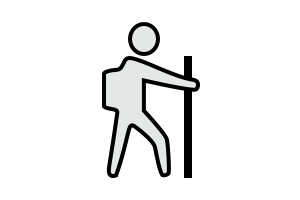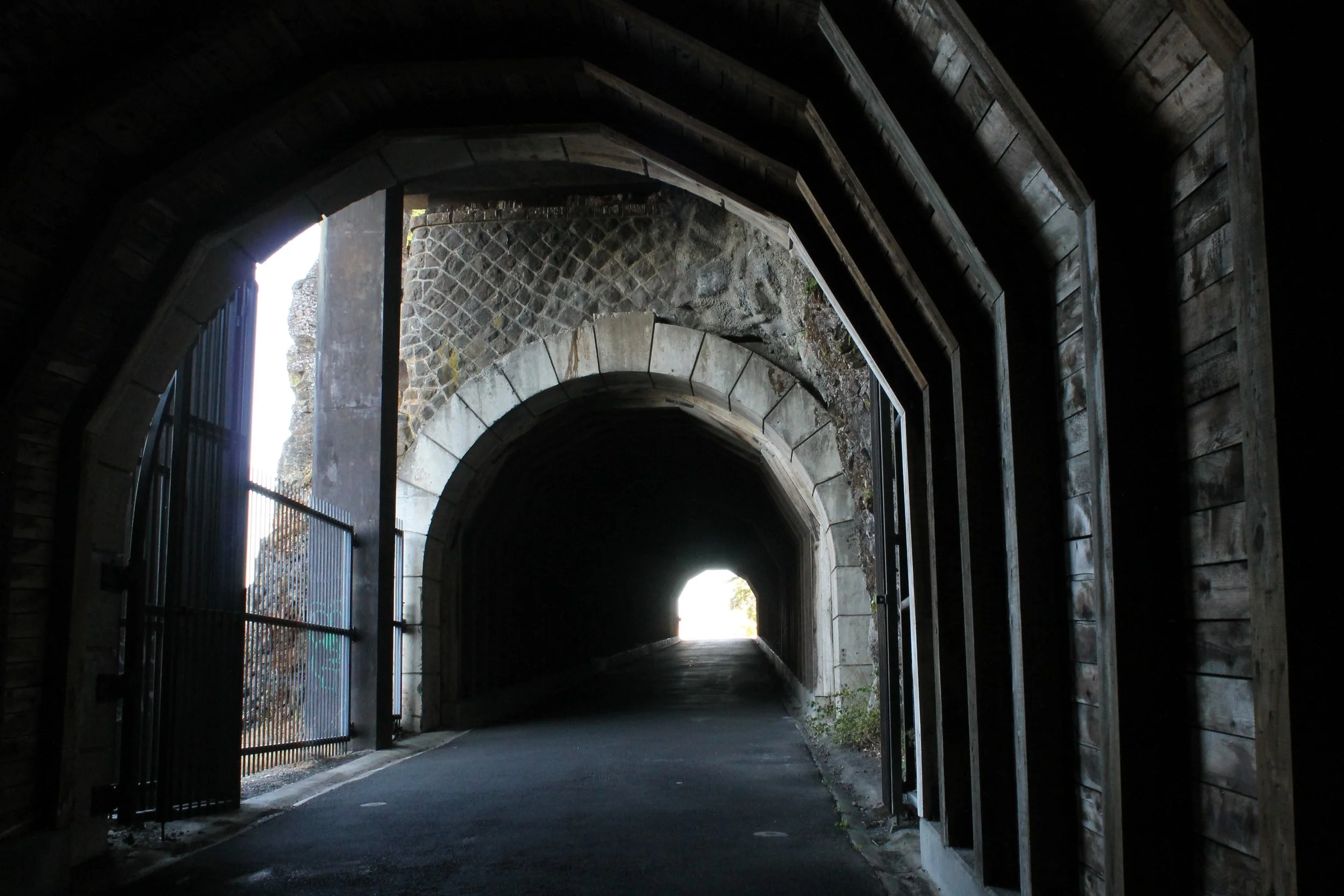Explore the Mosier Twin Tunnels
Entering the Mosier Twin Tunnels
The trail to the Mosier Twin Tunnels near Hood River, Oregon is, in my opinion, one of the most underrated in the Columbia River Gorge. The tunnels are impressive passages through solid walls of basalt, a legacy of the efforts in the early 20th century to make the Columbia Gorge accessible to cars. Today, the trail is for bikes and pedestrians only. Whether you are walking or biking, this easy, paved trail packs in phenomenal views and scenery from start to finish. Here is what you need to know before heading out to the Mosier Twin Tunnels.
Know before you go
The Mosier Twin Tunnels trail is a car-free road that runs between the Mark Hatfield West trailhead in Hood River and the Mark Hatfield East trailhead in Mosier. You can start from either.
There are restrooms near both trailheads.
The full hike is 9 miles out and back. It is still worth doing if you want to go a shorter distance. If you aren’t doing the full hike, I suggest starting at the east trailhead, which is closer to the Mosier Twin Tunnels. If you turn around after seeing the tunnels, it will only be about 2 miles roundtrip. There will also be an excellent overlook of the Columbia Gorge just before you reach the tunnels.
The trail is shared between bikes and pedestrians. Because it is fairly long and paved throughout, it is at least as good of a bike ride as a hike. There are some hills, but it never gets too steep and is a fun outing with kids.
Leashed dogs are allowed on the trail.
East tunnel
West tunnel
About the Mosier Twin Tunnels
The Mosier Twin Tunnels were once part of the Historic Columbia River Highway, a road that is equal parts art and architecture. They were built in 1921 when workers dynamited a tunnel through cliffs of basalt to create a passage for cars through the Columbia Gorge. After undergoing a series of updates to accommodate larger car sizes through the years, this section of the highway was eventually replaced by Interstate 84 and the tunnels fell into disrepair.
Viewing window from the Mosier Twin Tunnels
The tunnels have had a rebirth thanks to a massive restoration project that was completed in 2000. They are now part of a completely car-free paved trail between Hood River and Mosier that was designed to highlight the scenery of the Columbia Gorge. The tunnels were rebuilt, but still recall the grandeur of the original Historic Columbia River Highway. Large beams of wood and steel reinforce their impressive arches. Several viewing windows look out onto the Columbia River and the Washington side of the Columbia Gorge, making the tunnels feel a bit like castle turrets.
Look for Eighteen Mile Island in the Columbia River from the overlook east of the tunnels and from the viewing windows inside them.
Mosier Twin Tunnels trail
Plant life along the trail
There is a notable change in vegetation once you pass through the Mosier Twin Tunnels. On the eastern side, you will find grassy scablands, scattered pine trees, and piles of lava rock. This area of the trail is a good place to look for wildflowers in spring and summer. A few California poppies were still blooming during my fall visit.
The western side is more forested with typical Pacific Northwest plants like Douglas fir and maple trees. Although not shaded throughout, there are good sections of shade along the trail.
Overlooking Mosier and the Columbia Gorge from the Twin Tunnels trail
Coyote Wall seen from across the Columbia River
Geology
Although the tunnels are impressive, the highlights of this hike for me are the natural rock features. The overlook just east of the Mosier Twin Tunnels offers one of the best views you can get of Washington’s Coyote Wall, a diagonal cliff of columnar basalt several hundred feet high. Its distinctive angle, known as a syncline, is thought to come from folding caused by compression of the crust. Coyote Wall is not the only example you can see of this folding along the area of the Gorge known as the Yakima Fold Belt, where the rotation of Oregon into a relatively stable Washington has produced some incredible rock formations.
The Mosier Twin Tunnels trail is in an area of the Gorge where the pine forests start to give way to grassy hills and bluffs. The sparser tree cover makes it easier to see the rocky anatomy of the Gorge. The rocks you see along the Mosier Twin Tunnels trail are part of the Columbia River Basalt Group, resulting from lava flows that occurred around 15-16 million years ago from fissures in the east.
Mark Hatfield West Overlook
Cost and parking
There are parking lots at both the Mark Hatfield East and Mark Hatfield West trailheads. Both require the Oregon State Parks pass, which is $5 a day unless you have an annual or 2-year Oregon State Parks pass. There are fee stations at either trailhead to pay on-site. The west entrance has a credit card machine and a visitor’s center. The east entrance is a bit more rustic, but you can fill out your credit card information on a payment envelope there to pay.
If you park at the Mark Hartfield east entrance, avoid the temptation to take the small dirt trail near the pay station and restrooms. It doesn’t lead anywhere (ask me how I know). To get to the Twin Tunnels hike, head back toward the road and look for the sign that says “Trail.” Follow it to the right and cross at the crosswalk to reach the paved trail.
The trailhead at the west entrance is more obvious. Look for the paved trail near the pay station. At the other end of the parking lot, there is a short unpaved loop trail (about 0.25 miles) that leads to an overlook of the Columbia River. It’s not a bad stop, but the views on the trail itself will be more impressive.
Between the Mosier Twin Tunnels
Getting there
To reach the Mark Hatfield West trailhead from Portland:
Take I-84 East until Exit 64 in Hood River. Turn right onto Button Bridge Road from the exit, then turn left onto Old Columbia River Drive at the four-way stop. Follow Old Columbia River Drive a little over a mile and you will reach the parking lot. The drive will take about an hour.
To reach the Mark Hatfield East trailhead from Portland:
Take I-84 East until Exit 69 towards Mosier. Turn left onto Highway 30 and then take another left onto Rock Creek Road. There is a sandwich board sign on Rock Creek Road to mark the turn for the Mosier Twin Tunnels hike. Follow it a little over a half mile and the parking lot will be on your left. The drive takes a little over an hour.
Explore nearby
Check out these day trip ideas for things to do in the area:
Hike the Mosier Plateau and then stop by Idiot’s Grace Winery in Mosier.
See the Rowena Crest overlook and hiking trails, then head to Stave and Stone Vineyard in Hood River.
Explore the best of The Dalles, Oregon.
Go fruit picking in the Hood River Fruit Loop.
For hikes closer to Portland, check out these trails.
Enjoy the Mosier Twin Tunnels!
With love,
Emma
Eighteen Mile Island in the Columbia River
References:
Miller, Marli Bryant. Roadside Geology of Oregon. Missoula, Montana: Mountain Press Publishing Company, 2014.
Learn more about the history of the Mosier Twin Tunnels here.














